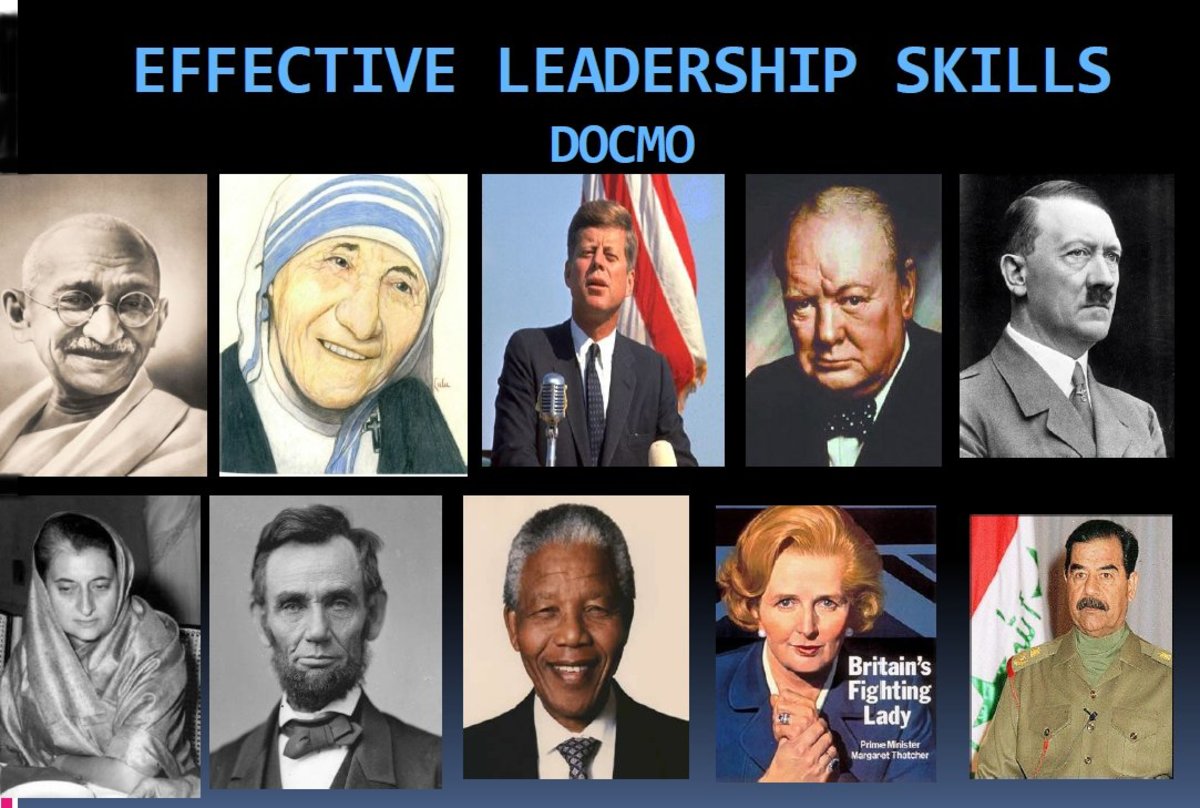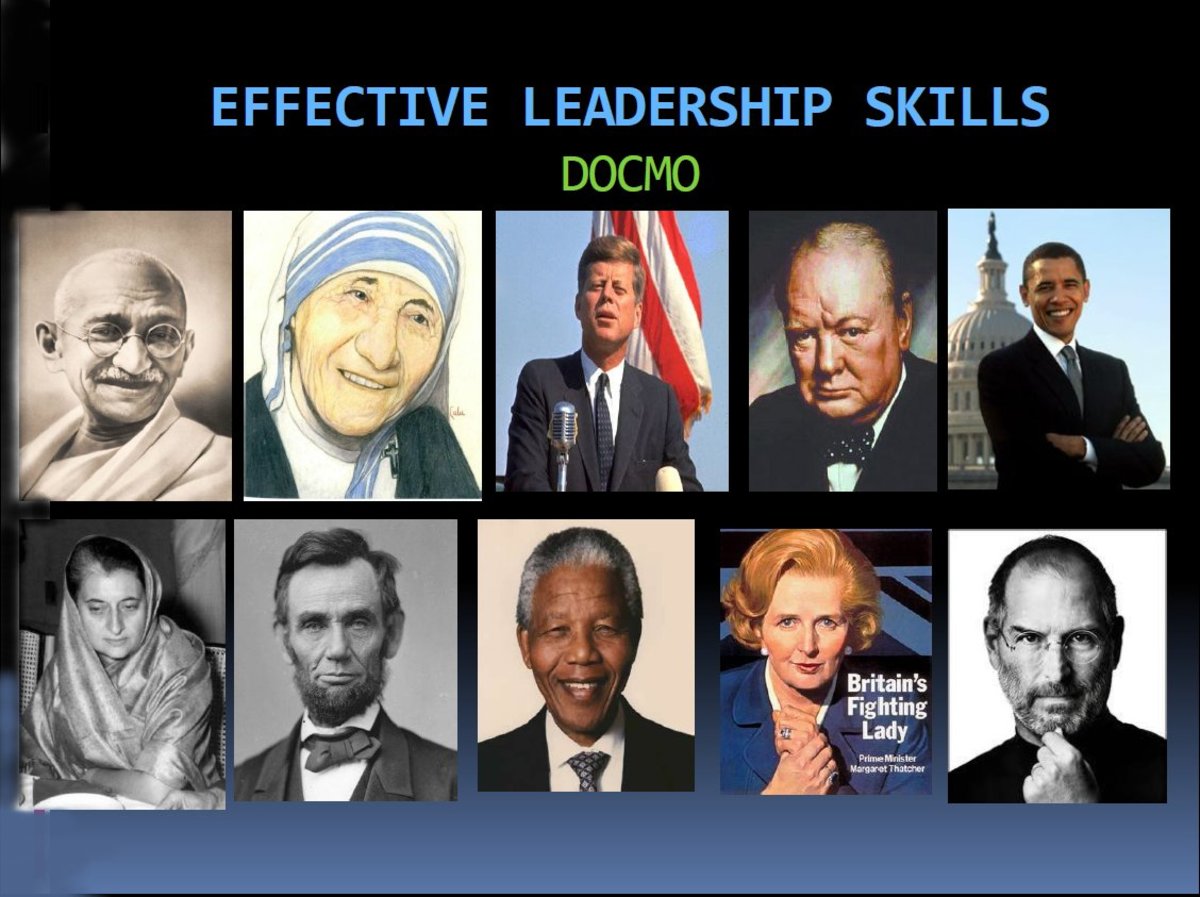My Thoughts On Effective Leadership


My Thoughts On Effective Leadership
June 14, 2013
Winston Wayne Wilson
@wwaynewilson
"Never tell people how to do things. Tell them what to do and they will surprise you with their ingenuity." - General George S. Patton, Jr.
We are all leaders of something – a company, a department, a team, our families and friends, or our communities. However, the biggest leadership responsibility you will ever have is leading yourself because, if you don’t have the courage and vision to lead yourself, you will struggle with the responsibility of leading others. That said, whether we do a good job or not, the leadership responsibility is always there. The good news is that leaders are made. Thus, we can all be coached into being more effective leaders. There are levels to leadership and, over time, we can climb each rung on the ladder of leadership if we are committed to learning and growing as leaders.
There are probably too many books written on leadership. As you can see from the pictures for this article (and there are still other shelves that are not shown), I suffer from C.B.A.D – chronic book acquisition disorder, particularly when it comes to books on leadership. Today I would like to share a few of my own thoughts on leadership based on my sojourn through the halls of corporate privilege as well as through life. Here are five things that I believe effective leaders are aware of and do particularly well:
- Leadership is about service. One of the biggest misunderstandings about leadership is that it is all about the leader. The reality is that leadership is all about what the leader does for the people. Effective leaders make decisions that are in the best interest of the people they serve rather than what is best for them. When leaders are self-absorbed, the people they serve become famished and ragged from servitude that exclusively honors the leaders. When necessary, effective leaders are able to roll up their sleeves and help the team. Herb Kelleher, the Co-founder, and former CEO of Southwest Airlines, was well-known for rolling up his sleeves. On some days, he would proudly work the gates and handle baggage. He loved his company and he did not consider any task to be too menial or unimportant. All tasks were considered critical to executing the strategy. There are similar stories about pilots from Southwest Airlines who, after completing their pre-flight checklists, would help the baggage handlers so that, collectively, the team could honor the airlines’ customer service commitment to leave on time and arrive on time. Kelleher clearly left his mark on the leaders he developed and empowered them to serve others rather than being served by others.
- Leadership is about empowerment. As the quote above by General George S. Patton states, “Never tell people how to do things.” Leading is not the same as “bossing”. Leaders stand at the helm of a vision, a strategy or a cause and they empower people to execute on that vision, strategy or cause. If you want to know the level of effectiveness of a leader, look at the condition of the people he or she serves. I always know when effective leadership is present when I walk into a company, department, home, or community and see empowered people rowing in the same direction; collaboratively executing a strategy; embracing and upholding a unified vision; and respecting as well as holding each other accountable, even when the leader is nowhere in sight. When I observe this, I always know that the leader has served the people well because the greatest gift a leader can give is empowerment. Empowerment occurs when there is clarity about what people need to do – i.e. what their roles are and the results their leaders expect them to produce. Leaders do not need to micromanage or dictate how people get the results; however, they should hold people accountable if they consistently fail to deliver results that their clearly defined roles require. When there are pervasive gaps between what leaders expect and what employees produce, it means that there is no clarity and roles and expectations are vague. When information, about roles and expectations, is vague, employees will not be empowered to consistently execute or deliver results. According to Dr. D. Kiley, “Vague information almost always leads to assumptions and those assumptions are almost always wrong.” Great leaders clearly communicate their strategy, vision, values, good news, bad news, roles, responsibilities, and expectations so that the people they lead can be empowered to produce desirable results.
- Leadership is shared. Leaders develop other leaders. Few people give thought to empowering others to take their jobs; however, great leaders do exactly that. Since there is a perennial shortage of great leaders, a great leader never has to worry about job security. Roughly speaking, for every 10 people you directly lead, groom at least one or two people who could succeed you. The absence of a succession plan is like not having insurance when your job is hazardous and you have a spouse and four young children living in a house where the mortgage is under water. One of the biggest downfalls of leadership occurs when it becomes singular and selfish. Sharing leadership does not mean that someone is sharing your corner office, authority, title, or compensation package. Shared leadership is about involving others in the development of strategies and ideas as well as in the making of key decisions. Leadership is not about etching your thoughts and ideas in stone, atop a mountain, and then climbing down to the bottom of the mountain to dictate to the masses. Shared leadership involves listening, collaborating, giving credit where credit is due, seeking feedback, soliciting input, acknowledging mistakes, and actively giving voice to the people you lead. There is nothing that demonstrates shared leadership more than when a leader, without flinching, hands over a mike to someone he or she leads. Too often leaders compete with the people they lead for the spotlight, the perks, and the glory. I always worry when I walk into a meeting with senior management of a company and the leader does all the talking for the entire duration of the meeting, while the other people, with titles the size of Texas, sit like quiet ciphers in the back of the room. Effective leaders are happy to see others shine. The job of the General of the Army is not to compete with the soldiers for the honor and glory so that he can add more stars to his uniform. There are many layers of effective leadership that are required to win a war and the General of the Army cannot execute all of them. When a leader is the chief cook and bottle washer in an organization, I always know that trouble lies ahead. If leadership is not shared, success cannot be optimized.
- Leadership leverages uncertainty . Great leaders are able to focus, execute and make tough decisions during tough and uncertain times. Leaders are not just expected to talk the talk but, more importantly, to walk the walk, even when there is chaos or uncertainty in sight. One of my favorite quotes about leveraging uncertainty comes from Dr. Ellen Langer, a Harvard professor, who contends that the biggest mistake any leader can make is being certain. She adds that, “Things are constantly changing. Things are unpredictable. When we confuse the stability of our mindsets with the stability of the underlying phenomenon, we act as if we know. When you think you know, you don’t pay any attention any longer – why bother, since you know. Since things are always changing, uncertainty should be the rule and what you want is a leader to learn how to exploit the power in uncertainty.“ Uncertainty, I’m sure, was the rule for Sully Sullenberger, which helped him to successfully land a US Airways plane (Flight 1549) into the Hudson River on January 15, 2009, after the plane was disabled by a flock of geese. All of the 155 passengers and crew survived. When uncertainty becomes the rule, leaders do not become hot and bothered by it. As a matter of fact, when uncertainty barges into a leader’s office, unannounced, with fire flaring from its nostrils, a great leader stares uncertainty in the face and says, “Welcome. I’ve been waiting for you.” This is precisely what doctors in the ER do because chaos and uncertainty are all part of a normal day for them. I was speaking to a manager once and he confided in me that he was becoming demoralized by a particular client because the client was always disorganized, unprepared, late in responding to his requests, and everything was always chaotic. My advice to him was to invest some time to learn how to become the manager who is great at managing chaos and uncertainty. We all would like to manage order and certainty with our eyes closed; however, we distinguish ourselves more when we are able to effectively manage chaos and uncertainty with our eyes wide open. Chaos and uncertainty are the indestructible, ubiquitous twins. They are like hecklers at a comedy show - your best strategy is to learn how to perform as a leader, despite their disruptive presence.
- Leadership inspires diversity. One of the things I avoid as a leader is treating people like they are single-celled organisms – you know, like amoebas that have been programmed to get the job done my way. People are not one dimensional. People from all backgrounds, with all kinds of interests, come to an organization. Some might have held leadership positions in various associations and clubs in college; some run marathons; others travel the world – they all have unique backgrounds and have many things that they are passionate about. Great leaders understand that people do not have to sacrifice the core of who they are to get the job done. In fact, great leaders leverage the core of who people are to help them achieve their personal best. When each person achieves his or her personal best, there is positive contagion to the organization and its clients. The more fulfilled people are outside of work and the more they feel connected and listened to at work, the better their work products and client service. One of the jobs of a leader is not just to attract a diverse group of people to the organization but to also encourage diversity of thoughts and ideas. Where there is diversity of people and thoughts, there will be creativity and innovation. When I think of creativity and innovation, I think of Thomas Edison. Edison was an inventor who encouraged his diverse group of over 5,000 employees to each come up with 10 ideas a day. What was the result of that creative license? The result was that, with the help of his employees, Edison was able to apply for over 400 patents per year and, at the time of his death in 1931, had 1,093 patents recorded, which is more than any other individual in America's history. Great leaders understand the creative genius of diversity of people and thoughts.
Since we are all leaders of something, my challenge for you today, is to think about your own leadership experience (with respect to your job, family and friends, community and yourself) and ask the following questions: Do I embrace the right attitude about service? Do I empower those around me? Do I share my leadership with others by involving them in key decisions? Am I scared and powerless in the face of uncertainty or do I leverage it? And, do I encourage diversity in people and in thoughts? Keep asking yourself these questions as you continue on your leadership journey. Remember that if you don’t like your answer to any of these questions, you can learn to become a better leader. Enjoy your day.







